由艾志環(huán)保管接技術(shù)股份有限公司自主研發(fā)的雙剖分旋轉(zhuǎn)油封論文在國(guó)外權(quán)威雜志Valve World 2015年2月期刊上獲得發(fā)表,??伤魅≈形姆g版本,。英文原文如下:
Arrow-Hook
The next generation of uniquely-cut split rotary seals Published in Feb. issue, Valve World, P71-72
To split a polymer-made rotary seal would be easy--a scissor will do the job, but will it work? Probably not.
By rotary seal, we mean those widely used oil seals made of polymer materials, not metal bearing protectors or mechanical seals which are limited to small sizes and much more expensive. The first requirement to split such a rotary seal would be its ability to “seal-back”. And the second requirement will be its ability to “l(fā)ock-back”. A simple cut will not only generate a leak path, but also destroy the polymer unity. Over time the material will shrink and therefore widen the gap. The motion and shaft run-out will only make it worse. To maintain a seal at the split will be difficult. There is also a third requirement. | 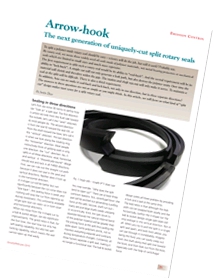 |
In addition, how can we make it seal-back and lock-back, not only in one direction, but in three separate directions? The answers to these questions are not as simple as you might think. In this article, we will focus on what kind of “split cut “design makes most sense for a split rotary seal.
By Justin Zhao
Sealing in three directions
Let’s first use some 3D terms to define how we “l(fā)ook at” a split seal. The first direction is where we look from the fluid side toward the outside, let’s call it the “axial” direction as most people do. The second direction is from the seal ID toward the seal OD, or from the shaft toward the bore; let’s call it the “vertical” direction. The last direction is when we look along the rotating ring; let’s call it “horizontal” direction. Most people instinctively think of splitting seals in only one direction: the “cut” direction. No, it splits in all three directions: axial, horizontal and vertical. A “theoretically-sound” design should seal and lock in all THREE directions.
First, we can rule out the straight cut path because it does not seal in the axial and vertical directions. Neither does it lock up in the horizontal direction.
A V-shape cut will be better but not significantly because the cut curve does not ”bite back”,
the sealing force is weak and nothing will stop the cut from opening up during movement. This commonly available single-split seal can open up in both axial and horizontal directions.
Fig.1 Single Split – straight & V-shape Type
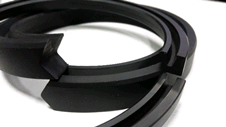
When we move from the V-shape cut to a ball& socket design, we see significant improvements. The good news is that, for the first time, this seal now not only has self-sealing capability, but also has self-locking capability, which means the seal cannot open up that easily.
You may wonder ”Why does the split tend to open up?” There are at least three common reasons: first, centrifugal force--the seal will be pushed out generating a pulling force at the split; Second, shaft run-out—many old and large shafts rotate unevenly or eccentrically; third, the split tends to separate because the natural internal bond of the polymer material will be greater than the joining force at the split thus pulling the splits apart. Some polymers shrink, not to mention everything expands and contracts during temperature changes. Combined, all three factors separate a split seal, making it no longer a functional seal. The ball & socket design solves all three problem by providing a lock and a seal at the same time.
The bad news is that although the leak path can be stopped both axially and the horizontally, neither the V-shape nor the “ball & socket” design single split seals will stop leakage in the vertical direction. Not at all. When you try to pull the split in a single split seal apart, and look from above, you can see through it immediately. Imagine being the fluid, you can easily creep out from shaft along that split line toward the bore, and then leak out from the bore, especially with the help of centrifugal force.
So, as you can see, almost all single split seals in the market will meet the sealing requirements in only one or two directions, but will not meet all “3D” requirements in an economical way. That is, not until recently.
Locking in three directions
To meet this 3D requirement, we can either design a unique stepped single insert, or choose a double-ring split seal. After several tests, we have concluded the latter option is much more practical to manufacture.
For example, a patented double-ring double-lock split seal has the capability of sealing axially, horizontally, and vertically. If you pull the split apart by 2-3mm, you cannot see through it from any of the three directions. In addition, it locks as well in all three directions, even between the two rings there is a locking mechanism.
Fig.2 Patented AIGI 5505 double split seal

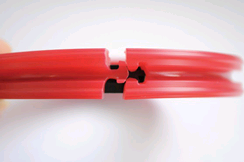
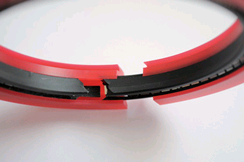
This double-ring double-lock split seal is a proven product with over five years of field testing and more than 10,000 successful applications. But over time, we found further improvement necessary. Although the design meets the sealing and locking requirement, it has one problem: relaxation.
No matter how good the polymer quality is, it shrinks during cooling, expands during heating, and changes shape over time, just like our human bodies. On Initial installation this ball & socket design has some “push-back” force, but the force disappears as the polymer relaxes. In order to stop this relaxation process, there has to be a more permanent push-back force against opening up at the split.
This brings us to the next generation of strange cut split seals. From several design options we have come up with the new “Angle-hook Lock design” as shown in Figure 3.
Different from all previous ones, this seal has a much more permanent locking mechanism. During shaft run-out or movement, the hook will not yield to pulling force therefore keeping the seal splits in contact.
We not only use the Arrow-hook locking mechanism on one ring, but also use it to lock two different rings together. Not so obviously, the two rings of a double seal could separate as well. Why is that? Other than reasons already mentioned, there are two additional factors. Firstly, there is the frictional force- the inner ring has much larger friction than the outer ring. Secondly, material differences- a double seal usually has two different materials, therefore different heat expansion rates.
As shown in Figure 3, the double-ring, double split seal design, has a total of three “arrow hooks”, one on the outer ring, one on the inner ring, and one between the two rings.
Fig.3 AIGI 5505 “Arrow-hook”
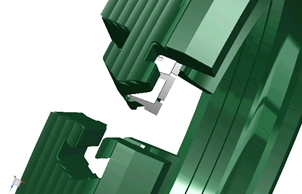 | 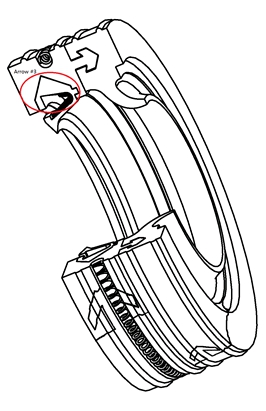 |
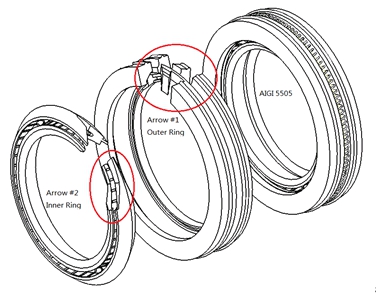 |
With this double-ring double-lock Arrow-Hook split rotary seal, now we can assure ourselves of a sound design.